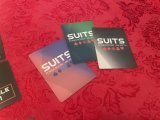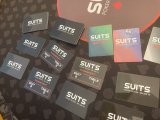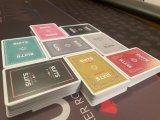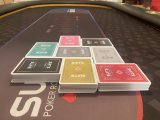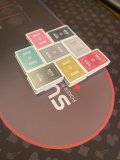Hey
@MrRossKeys, these chips look sweet. I've been playing around with the
CPC design tool and also thinking about messing around designing a set in Illustrator for the future. I wondering if there were any tips you had or general guidelines for going about designing a ceramic set.
What led you to go with a ceramic mold design vs other options? I'm not sure what the pricing or quality differences are so that likely played a factor.
Thanks for the kind words!
Ceramics are about 10x cheaper in many cases. Quality is a dealbreaker for some; they arent clay and dont feel like it, but very customizable and loved by many chippers.
This is so true. Pricing is a pretty big consideration in favor of ceramics. I started this project as a
CPC project. To get the number of chips and denominations I wanted, I was already north of $4,000 for 1200 chips. The ceramics I ordered came out to $900 for 1600 chips including shipping, taxes, and fees.
I've purchased ceramics from Sunfly in the past so I'm familiar with the difference in feel. I currently own 3
CPC sets, 1 ceramic set, and 1 metal slug ABS set. So for this new set I really focused on creating graphics and colors that were different from my current sets. I found the
Tina/mold vendor's colors to be superior to Sunfly's, and I liked that I could create colors outside of
CPC's color palette.
For tips and guidelines for designing the ceramic set... wow, where do I start?
1. I'd say learning or partnering with someone who uses Adobe Illustrator is probably one of the most essential parts of the process. The manufacturer uses Illustrator, so it's been pretty easy sending them my files directly, and when they have a question or request they've sent Illustrator files back to me for proofing, etc. I had used Photoshop for years but had been putting off learning Illustrator. This project was the perfect excuse to buckle down and figure it out.
I can say now that I am really comfortable using Illustrator for poker chips.. maybe i've unlocked like 20-25% of what Illustrator can do, and it's plenty enough so far to take a project from concept to finished design.
2. There are lots of little technical things necessary in relation to designing for print (like using CMYK instead of RGB) for example. I won't get into those here, but just know that you (or your designer) will be working with measurements and specifications a lot.
3. This one was probably the hardest part for me personally. When using the
CPC tool, selecting a color for chip base or edge spot is easy and built into the tool. The selection makes the graphic update immediately including the rolling edge, so the creative part of the brain is given instant feedback. AND, there are limitations to the colors that you can choose, which is both a limitation and a good thing.
When making ceramic chips, theoretically you have all of the colors available to you... at least in the design process. The manufacturer may not be able to print the colors you choose, so there are some limitations, but there are less limitations in practice than there are with choosing colors from the
CPC tool. Because there are more color options with ceramics, it takes longer to find the right shade, hue, saturation for the color you may be thinking of for a chip or edge.
If it took XX number of revisions to be happy with a chip using the
CPC tool, it easily took XXX or XXXX number of revisions when designing my ceramic set.
So, my tip for all of this: try to create your palette first before embarking on chip colors. Use a pre-made palette from
CPC, Paulson, Sunfly, previous
Tina/mold buys, etc.. I think doing this will cut down on design time by a LOT. Of course you could deviate from the palette to find an exotic color as needed, but then be sure the manufacturer can print that color.
4. Get as much visual feedback as you can. For me this means not only creating the poker chip face and edge, but also creating alternate views of the poker chip (from the side, chip stacks, etc). It's crazy to me how different a chip can look when comparing just the front to the rolling edge in a stack. Sometimes I've fallen in love with a designed chip face only to discover that the chip in a stack looks bad (not enough contrast, colors too close to other chips, etc).
You've seen a couple of my renders in this thread of alternate views. Just know that I have hundreds more on my computer hard drive! Since these chips are an investment (even at a fraction of
CPC costs) I want them to be playable for at least 5-10 years until I decide to make or source a new set. And even beyond 10 years it would be nice if they held up and could be sold, gifted, or just retired in good condition. So I propose that anyone making ceramics try to get as much visual feedback as possible before placing the order so that they arrive pretty close to what they were intended to look like.
Hope this helps.


